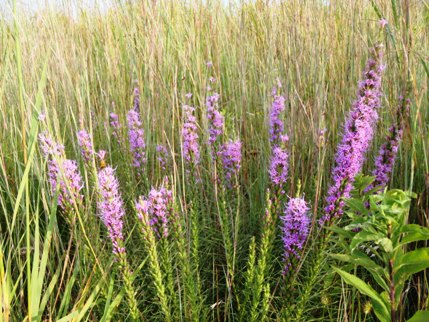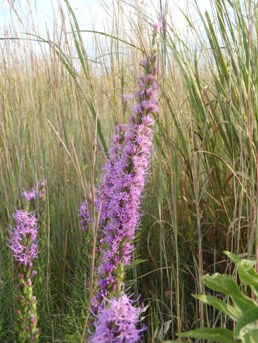Gayfeather, Liatris sp., is a beautiful wildflower to grow on any acreage or in a formal landscape setting. Gayfeather, Blazing Star, and Liatris are all three names for the same plant. The many species and varieties offer you choices of different sizes, colors, and time of bloom.
The Liatris is a beautiful plant. Most species grow to be one to five feet tall. The flowers are a large spike of many individual flowers that grow together to be about 15 inches tall. The flowers open from the top of the spike downward, with the exception of Liatris aspera, Rough Blazing Star, which opens from the bottom of the flower spike upward. They bloom in the late summer to early fall. Most often, Blazing Star flowers are purple but they also can be found in red and white. All Gayfeathers have spiked grass-like leaves that are typically much larger at the base of the plant and get smaller as you move up the plant. Gayfeather is grown from a corm, similar to how an iris grows, that sprouts in the spring.
Gayfeather is a great plant for an acreage because it is tough. It grows and produces flowers in poorer soil than most plants. It thrives in full sunlight and can withstand heat, cold, and drought conditions. Some of the species that you can choose from include Liatris pycnostachya (Tall Blazing Star or Kansas Gayfeather), L. punctata (Dotted Blazing Star), L. scariosa, and L. spicata. Kansas Gayfeather grows very well in Kansas and Nebraska environments. There are also many different cultivars within each of these species.
Liatris can be used in many different settings. It will add a little color to your pasture or in your native grass areas as well. It also serves as a focal point in your landscaping. Blazing Star is an attractive flower for bees and butterflies, so you can use it in your pollinator garden. In addition, you can use it as a cut flower, either fresh or dried.
This plant is not only beautiful for a landscape or wildflower prairie but it is also beneficial as food to wildlife and livestock. Deer, antelope, and livestock, especially sheep, use Gayfeather as food. It has good nutritional value for those animals as well. Overgrazing may reduce the population size of Liatris so be careful not to overgraze if you wish to keep it in a pasture. According to the Natural Resource Conservation Service (NRCS), Gayfeather has been used by American Indians for food and medicinal purposes including reducing inflammation, easing abdominal troubles, and as an antidote for snake bites.
If you are trying to find a new plant to mix into your prairie or as a focal point in a landscape setting, think of the Gayfeather, or Blazing Star, or Liatris. Whatever you choose to call it, the plant offers you many choices.


